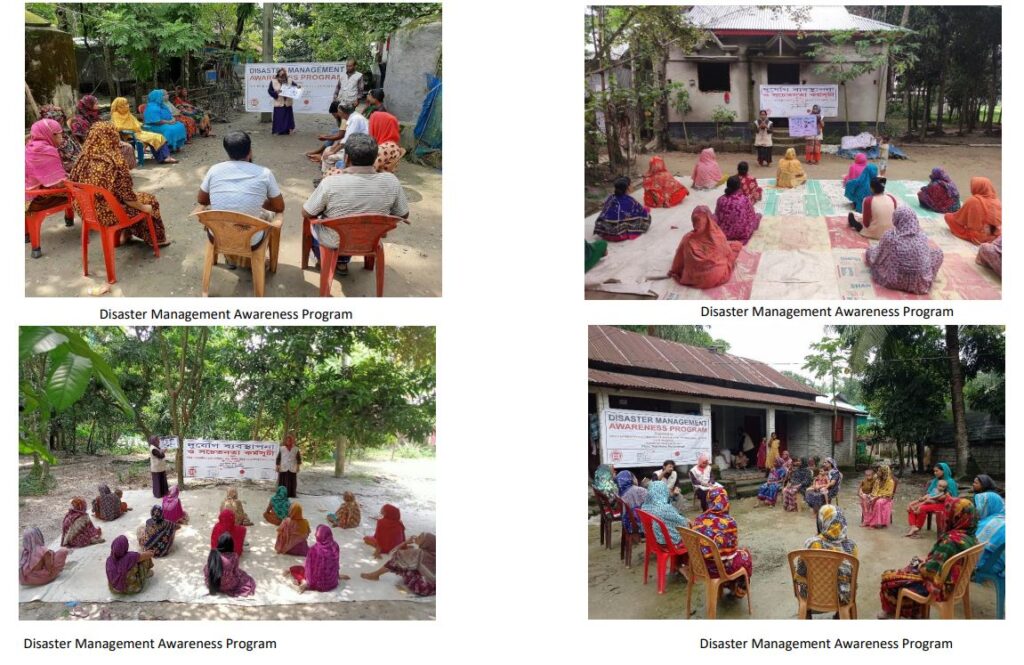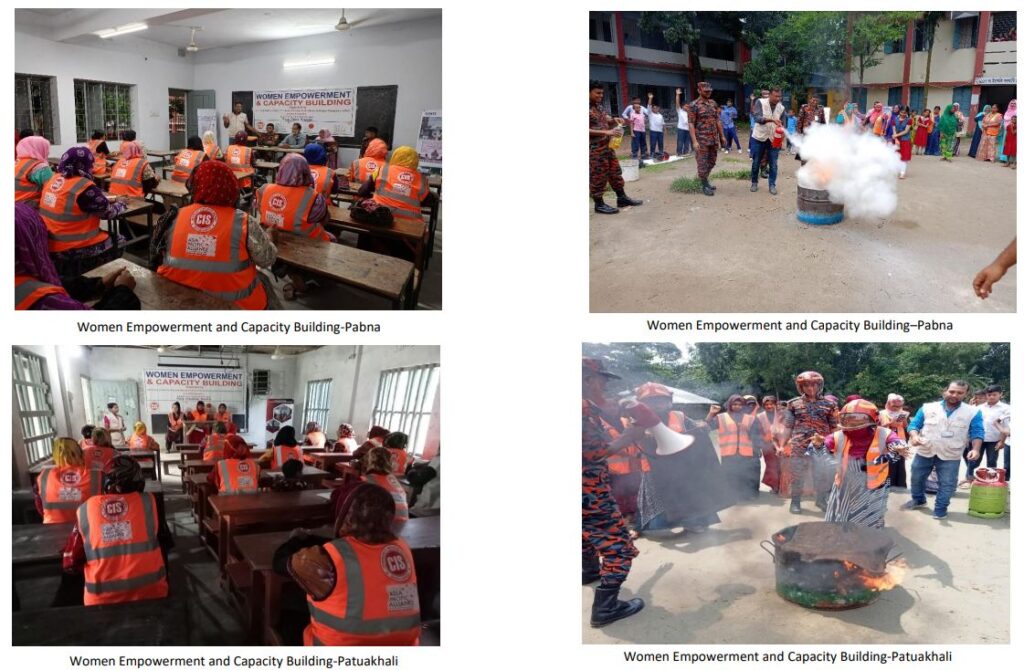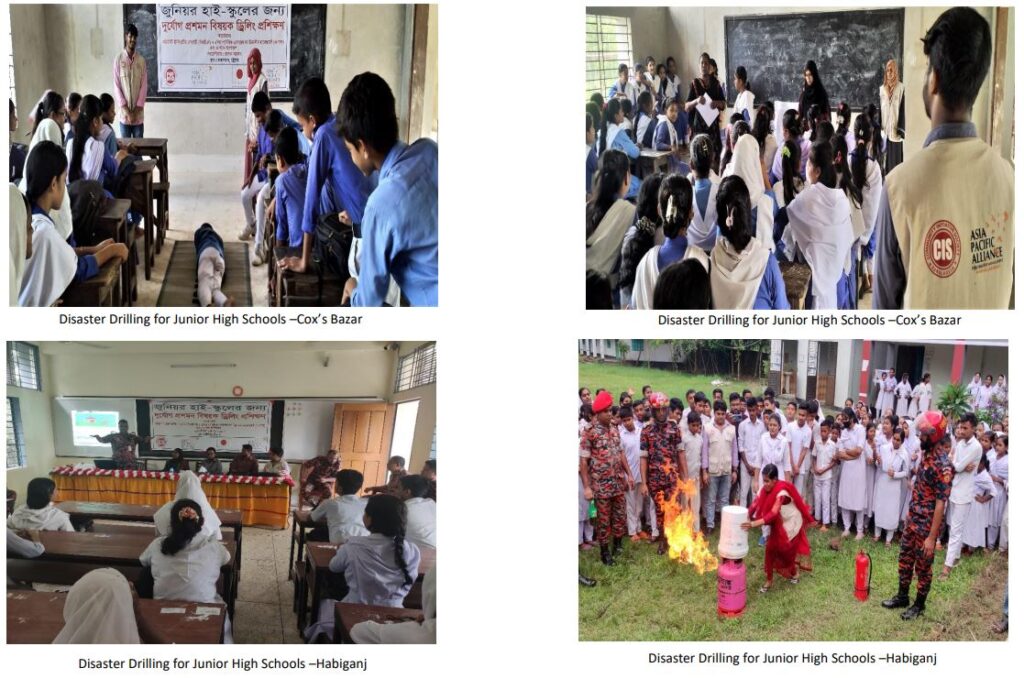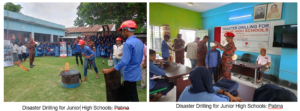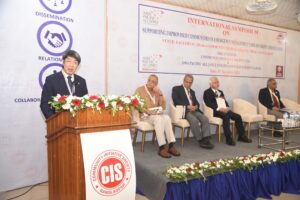Project Title: Strengthening Capacity for Sustainable Disaster Management Network by involving multi-sectoral platform Project Period: 17 January, 2023 – 16 January, 2024 (12 month)
- Project Activities and Accomplishments
Bangladesh is one of the most vulnerable countries to natural disasters and, due to climate change; we are facing natural disasters almost every year. Combined with the country’s geographical location, topography, and dense population, disaster events often result in high loss of life and economic loss, though Bangladesh has been successfully reducing the loss of human lives over the years. The frequency and intensity of natural disasters have increased in recent years due to climate change. The climatic events have serious consequences on broad agricultural sectors, food security, water, health, and sanitation and leave serious impacts on the life and livelihood of the communities. But so far we have limited disaster risk-related data to understand the depth of household and population characteristics and loss sustained by the community at the household levels.
A-PAD Bangladesh started the project in January 2023 and presently continues it on 17 January 2023 to build up capacity for disaster management. It communicates with the different sectors like the local community, community leaders, stakeholders, and GOVT. officials continuing training on disaster management. To hold a training program A-PAD Bangladesh staff organized small community meetings to share ideas on disasters and introduced them about A-PAD Bangladesh activity. A-PAD Bangladesh working 8 divisional areas.
There are 1 health workers in each divisions whose are doing home visit and aware the local community about basic disaster awareness. The health workers gave basic ideas about disaster management. A-PAD Bangladesh working at the rural areas. If there would be any directions or announcement from GOVT. or any disaster related news has been published the health workers delivered the message to the local community. Total 4,923 persons were benefited from A-PAD Bangladesh on August 2023.
A-PAD Bangladesh attended coordination meeting at the 8 divisions in Office of Deputy Commissioner. At that meeting different NGOs had joined and explained their activities. Besides this what will be the next activities of the GOVT. and NGOs were discussed at that meeting.
1. To manage the emergency disaster management coordination centers in disaster-prone areas (Outcome 1) The disaster management coordination center in disaster-vulnerable areas established in this project (3 year project) functions as a disaster response base in each region, and contributes for preventing the spread of health damage to local residents and community-led disaster risk reduction measures. | ||
Activities | Outcome Indicators to Measure Results: | Project Status: Achievements vs Outcome: If the activity is behind schedule, please write the reason. |
1-1 Operation of Emergency Disaster Management Coordination Centers Beneficiaries: 10 people x 25 days x 8 divisions x 12 months = 24,000 people 50 people x 8 campaign x 12 months = 4,800 people | 【Indicators of Outcome】 1-1: The disaster response management centers in 8 places (Dhaka, Chattagram, Rajshahi, Khulna, Barisal, Sylhet, Rangpur and Mymensingh division) will be utilized and the necessary equipment for emergency health care will be prepared. We will establish a new emergency disaster management coordination center in Mymensingh division. The center will function as a resource center for sharing information on disasters and will be used as a venue for strategic planning meetings, training and workshops. The staff members including doctors and nurses visit the villages and carry out awareness activities related to emergency health measures, public health and disaster prevention for local residents, and ensure that each local resident takes appropriate preventive measures. | Total of 3,213 people visited the Disaster Management Coordination Center to discuss disaster preparedness and health-related issues. Dhaka: 430 Persons Cox’s Bazar: 380 Persons Pabna: 368 Persons Bagerhat: 385 Persons Patuakhali: 430 Persons Habiganj: 400 Persons Rangpur: 405 Persons Netrokona: 415 Persons Total = 3,213 Persons |
1-2 Disaster Management Awareness program Beneficiaries:15 participants x 3 sessions x 8 divisions x 12 months = 4,320 people | A-PAD Bangladesh conducted Disaster Management Awareness programs at the 8 divisional areas where 377 persons participated. Total 3 times training was organized at each divisional area. Dhaka:15 Participants x 3 Sessions= 45+1=46 Participants Cox’s Bazar: 15 Participants x 3 Sessions=45+2=47 Participants | |
| (Indicator: number of visitors, record of services provided)
1-2: The PCR test lab installed in the previous project will continue to operate. In the first year of the project, testing will be conducted only for COVID-19. From the second year onwards, it will be expanded to other infectious diseases (tuberculosis, measles, hepatitis) according to the needs of local residents. (Indicator: number of tests, report of test results) | Pabna: 15 Participants x 3 Sessions= 45 Participants Bagerhat: 15 Participants x 3 Sessions= 45+3=48 Participants Patuakhali: 15 Participants x 3 Sessions= 45+5= 50 Participants Habiganj: 15 Participants x 3 Sessions= 45+2= 47 Participants Rangpur: 15 Participants x 3 Sessions= 45+4=49 Participants Netrokona: 15 Participants x 3 Sessions= 45 Participants |
1-3 Operation of PCR lab Beneficiaries: 15 people x 25 days x 12 months = 4500 people(Monthly Goal: 15 persons x 25 days = 375 persons) |
A-PAD Bangladesh established PCR Lab for COVID-19 test. In Bangladesh number of COVID-19 patients has average in number. In August 2023 total 480 COVID-19 test has been done | |
2 Strengthening the disaster response platform network (Outcome 2) A-PAD BGD, NPF for disaster reduction and disaster response through collaboration between multi-sectors, will be established and expanded, and the disaster prevention and disaster capacity of its member organizations will be strengthened. | ||
2-1 Network partner meeting Participants : 100 people x 5 villages x 8 divisions = 4000 people | 【Indicators of Outcome】 2-1 Strategies, mechanism and action plan meeting among networking partners and local communities will be held to support the building of disaster cooperation framework.
2-2 For the aim of awareness and increase the knowledge on disaster preparedness and management among the local community, we will organize different rally and meeting on the disaster preparedness and SDGs related | A-PAD Bangladesh organized Network Partner Meeting at Netrokona. 06 August 2023, Atithpur, Total Participants 100+2 10 August 2023, Nischintapur, Total Participants 100+3 16 August 2023, Godayun, Total Participants 100+2 24 August 2023, Durgapur, Total Participants 100+5 29 August 2023, Islampur, Total Participants 100+1 Netrakona district is one of the disaster-prone areas in Bangladesh. For geographic location and weather conditions, cyclone, tidal flood, erratic rainfall, cold wave, arsenic contamination, and tornado are common in this area. The main focus on Network Partner Meeting was on build up on capacity |
| national/international days like 05 November World Tsunami Awareness Day, 13 October Disaster Risk Reduction Day, 22 April Earth Day and 16 December Victory Day (National).
2-3 For the aim of strengthening of partner organizations, disaster risk reduction (DRR) training will be held. The training contents includes community-based disaster risk management, planning DRR strategies, and risk analysis that effectively identifies hazards, capacities and vulnerabilities. (Indicator: Partner organizations)
2-4 In this seminar, participants from various fields will be invited to exchange opinions and discuss ways to discover innovations related to DRR proposed by community residents and local companies and realize ideas and inventions. (Indicator: To create innovative solutions, we aim to create a successful model for disaster response by combining technology and knowledge that transcends fields and innovating)
2-5 The international symposium will be held in Dhaka to widely share the cooperation between multi-actors | on emergency response during and after disaster. CIS is playing an important role by creating awareness program and conducting such training, seminar and worksop on disaster reduction. He added that the roads are also submerged in the second phase of floods we give attention on infrastructure.
Evacuation procedures should be clearly defined and communicated to the affected population. This includes identifying evacuation routes, establishing transport arrangements, and coordinating with relevant stakeholders, such as local government authorities, to ensure the safe and efficient evacuation of the population. Shelter management involves the identification, preparation, and management of temporary shelter facilities for the affected population. This includes identifying suitable shelter locations, ensuring the availability of basic necessities such as food, water, and medical supplies, and coordinating with relevant stakeholders, such as local government authorities and humanitarian organizations, to provide support. |
2-2 Disaster Preparedness Campaigns
Participants:100 people x 2 times x 8 divisions = 1,600 people |
| |
2.3 Network Partners |
|
Capacity Strengthening (DRR) Participants:30 people x 2 org x 8 divisions x 2 times =960 people | at the central and regional levels in Bangladesh and the progress of the emergency health response system among participants who are involved in disaster response from inside and outside Bangladesh. International experts will be dispatched from A-PAD member countries to introduce advanced cases of NPF in each country. (Indicator: The international symposium will be held for a total of three days, one day for field trips (field visits), one day for pre-meetings, and one day for international symposiums.) |
|
2-4 Seminar for Developing New Disaster Prevention Solutions Participants:40persons x 8 divisions x 2times =640 participants | A-PAD Bangladesh organized Seminar 2 divisional areas Cox’s Bazar and Rangpur. 13-14 August 2023, Rangpur, Total Participants 40+2 16-17 August 2023, Cox’s Bazar, Total Participants 40+1 A Two-Daysseminar on ‘’Seminar for Developing New Disaster Prevention Solutions’’ was organized in Rangpur by CIS and A- PAD Bangladesh. Rangpur district is a geographically and historically traditional town in the northern part of Bangladesh. Disaster is a sudden, calamitous event bringing great damage, loss, destruction, and devastation to life and property. The damage caused by disasters is immeasurable and varies with the geographical location, climate, and the type of earth surface or degree of vulnerability. A total of 42 participants have attended that seminar. The seminar is designed for the local community, community leaders, stakeholders, and Govt. officials who are involved directly with disaster risk management and risk reduction. Additionally, and since the methodology is comprehensive in approach, it is also designed for sector specialists, providing a multi-sectorial overview of |
|
| the situation after a disaster, as well as an economic estimate of the damages, losses, and additional costs. CIS conducted seminar on New Disaster Prevention and Solution Seminar at Convention Hall of UNO office, Cox’s Bazar Sadar. Government, Non-government Organizations, NGO’s and Local Leaders were presented at the seminar. This seminar has two main aims to help people to avoid impending disaster threats and to put plans, resources and mechanisms in place to ensure that those who are affected receive adequate assistance. A disaster preparedness ‘plan’ can take several forms, ranging from a broad mitigation and preparedness strategy to a detailed contingency plan for responding to a particular hazard. In most plans, the operational priorities will be to save human life, meet people’s emergency needs (principally medical care, food, shelter and clothing) and restore facilities that are essential for health, safety and welfare ( hospitals, water and sanitation, power and transport). Rehabilitation and reconstruction are likely to be included in more strategic plans, although in practice they tend to be poorly integrated with emergency response. |
2-5 International Symposium on DRR
Participants:200 persons |
| |
3. Strengthening disaster resilience of local communities | ||
(Outcome 3) 3-1 Disaster response capacity building of local community level in Health and hygiene field | ||
3-1 a) ) Workshop on Disaster Management and Emergency Health Response
Participants:40 persons x 8 divisions x 2 times = 640 persons | 【Indicator of Outcome】 3-1 a) Workshops will be held to understand emergency disaster preparedness, health response and hygiene needs in communities, schools and homes and to learn how to respond during emergencies. Networks of stakeholders will be built through the workshop.
(Indicator: Local citizens, Community leaders, Local NGO, Private sector workers)
b) Workshop for healthworkersfrom local organizationswillbeheld to understand emergency health and hygieneneeds and learn how to respond to emergencies. The healthworkerswhofinishedthis trainings are supposed to becomemember of disastervolunteerrescue team in the activity. |
A-PAD Bangladesh organized Workshop on Disaster Management and Emergency Health Response at Dhaka where 43 participants
21-22 August 2023, Dhaka, Total Participants 40+3
DRR strategies and the health sector are profoundly associated with each other. The main focus of the training workshop was on building upon capacity for disaster response and emergency health response during and after a disaster. At the 2 days workshop in Dhaka, it was focused on the different sectors and different topics. A total of 43 participants from the local community, Health Sector, local NGO, and private organizations from Dhaka had joined the training workshop. At the time of response to disasters and emergencies, the priority is to help, support, and treat the victims; and to save lives. The main focus of the training workshop was to build up capacity for disaster response and emergency health response during and after the disaster. The training is based on the main disaster which is mainly man-made in Dhaka City is the excessive heat. Dengue fever is an emerging issue in Dhaka city and all the hospitals are full of dengue patients. If safety measures can be taken properly in this situation to reduce the Adis mosquitoes. GOVT. said that it was the second-highest dengue fever that occurred in Dhaka. At that workshop, it also discussed if there will be dengue fever and what treatment |
|
| should start at home as there is a shortage of hospitals. |
3-1 b) Training of Local Health Workers on Disaster Health Activities
Participants:25 pers/time x 8 divisions = 200 persons | A-PAD Bangladesh organized local health worker training at Bagerhat. 08-10 August 2023, Bagerhat, Total Participants 25+2
Bagerhat is one of the districts in Bangladesh. Many community people live here. The main focus of the training workshop was to build up capacity for emergency health response during and after a disaster. A total of 27 participants from different organizations like NGOs, private organizations health workers at the union level from Bagerhat joined that training workshop. The Capacity Building Initiative for Disaster Preparedness and Response in Bangladesh seeks to build the capacity of these entities to support the enhanced resilience of communities to prepare for, respond to, and recover from emergencies. The training programs focus on the disaster and health sector, both sides Bagerhat is one of the disaster-prone areas where different time’s disaster hit that area. The disaster in Bagerhat is Cyclone, salinity, flood, and water logging. In the training workshop there was discussion on activities that need to be kept in mind during parallel disaster like COVID-19. During the training, the workshop focused on the different disasters as all the disasters are related to health and the health providers are the front liner who works directly with the community so they are at the risk. During the workshops, the participants shared their feedback from their practical experiences. Besides this, the facilitator shared technical knowledge with them so that they can play a vital role during the disaster in the future. | |
3-2 Strengthening disaster response capacities of local communities through disaster drilling training | ||
3-2 a) Women Empowerment and Capacity Building Participants:20 persons X 8 Divisions X 2 Session = 320 participants | 3-2 a)Building women empower and capacity building through improving their knowledge and skills on disaster risk reduction, in order to involve them in disaster planning and policy making. A women’s group will be trained in the field of maternal and child health, hygiene and environment sanitation, nutrition. (Indicator: A women’s group will be trained in the field of maternal and child health, hygiene and environment sanitation, nutrition.)
b) Drilling training session will be conduct to the local stakeholders, youth group and homes and to learn how to respond the fire, flood, cyclone, landslide and earthquake disasters and rescue at the emergencies. To conduct this training session, we will prepare a training manual and a curriculum collaboration with the department of fire service and civil defense of GoB. (Indicator: After the practical training session two disaster volunteer rescue team will be established in each divisional area.)
c) Drilling training session for the public junior high school students and teachers will conduct at the |
A-PAD Bangladesh organized Women Empowerment Capacity Building Training in 2 divisional areas.
16-17 August 2023, Pabna, Total Participants 20+3 20-21 August 2023, Galachipa , Total Participants 20+1
Gender inequality coupled with the climate crisis is one of the greatest challenges of our time. It poses threats to ways of life, livelihoods, health, safety and security for women and girls around the world. Across the world, women depend more on, yet have less access to, natural resources. In many regions, women bear a disproportionate responsibility for securing food, water, and fuel. When disasters strike, women are less likely to survive and more likely to be injured due to long standing gender inequalities that have created disparities in information, mobility, decision-making, and access to resources and training. In the aftermath, women and girls are less able to access relief and assistance, further threatening their livelihoods, wellbeing and recovery, and creating a vicious cycle of vulnerability to future disasters.
Women’s and girls’ health is endangered by climate change and disasters by limiting access to services and health care, as well as increasing risks related to maternal and child health. Research indicates that extreme heat increases incidence of stillbirth, and |
| school based focusing self-protection during and after disaster. Manual will be designed for the school children in cooperation with the department of fire service and civil defense of GoB (Indicator: Participated schools will be supported to develop their emergency management plans.)
In order to widely share and disseminate the activities of this project and the experiences and lessons learned through the activities, situation reports and activity reports in the event of a disaster will be published on the A-PAD BGD website. | climate change is increasing the spread of vector-borne illnesses such as malaria, dengue fever.
The initial outcomes of Women Empowerment and Capacity Building training include: 1. Increased self-awareness and confidence: Participants gain a deeper understanding of their own strengths, capabilities, and potential. They develop a sense of self-confidence and self-belief, empowering them to overcome obstacles and pursue their goals.
2. Improved knowledge and skills: The training equips participants with new knowledge, skills, and tools relevant to women’s empowerment and capacity building. This can include leadership skills, communication skills, problem- solving abilities, financial literacy, entrepreneurship skills, and more. Participants acquire practical skills that enable them to navigate various personal and professional challenges.
3. Enhanced decision-making and critical thinking: The training focuses on developing participants’ decision- making and critical thinking abilities. They learn how to analyze situations, assess options, and make informed decisions. This empowers them to take charge of their lives, |
|
| make strategic choices, and contribute effectively to their communities.
4. Strengthened networking and support systems: Participants have the opportunity to connect with like- minded individuals, creating a supportive network. This network provides ongoing support, encouragement, and collaboration opportunities, fostering a sense of community and empowerment.
5. Increased awareness of women’s rights and gender equality: The training emphasizes women’s rights, gender equality, and social justice issues. Participants gain a deeper understanding of their rights, the importance of equality, and the impact of gender-based discrimination. This awareness motivates them to advocate for gender equality and work towards social change.
6. Community engagement and leadership: The training encourages participants to actively engage in their communities and take on leadership roles. They are empowered to initiate and participate in community development projects, advocate for social causes, and contribute to decision-making processes. This fosters a sense of agency and allows participants to have a positive impact on their communities. |
|
| 7. Empowerment and personal growth: Through the training, |
participants experience personal growth and | ||
empowerment. They develop a stronger sense of identity, | ||
purpose, and direction in their lives. They become more | ||
resilient, adaptable, and open to embracing new | ||
opportunities. | ||
8. Ripple effect and multiplier effect: The impact of the | ||
training extends beyond individual participants. As trained | ||
individuals, they can share their knowledge and skills with | ||
others, creating a multiplier effect. This expands the reach | ||
of the training and promotes a culture of empowerment | ||
within their families, communities, and professional | ||
networks. | ||
3-2 b) Disaster Drilling for the Youth and Local | A-PAD Bangladesh conducted Disaster Drilling for the Youth and Stakeholder in Rangpur and patuakhali. | |
Stakeholders Participants : 45 persons x 8 divisions x 2 | 27-28 August 2023, Patuakhali, Total Participants 45+2 29-30 August 2023, Rangpur, Total Participants 45+3 | |
times = 720 persons | Youth constitute an invaluable human resource of a nation. | |
| They are physically strong, mentally agile, and look for change | |
| and dynamism in their own life and in the life of the community | |
| they live. The idea of involving youth and encouraging their | |
| participation in risk reduction will help us to build a resilient |
|
| community. equips young people to take on new roles and become active agents of change. Most jobs nowadays require applicants to have some experiences which are technically not taught theoretically in college class rooms. There must an employer who will be willing to offer an opportunity to on the job training. The inexperienced young people likewise need mentors in disaster preparedness process who are willing to work closely with them by involving them in active roles that gives them hands-on experience to eventually fill-in the shoes of their adult mentors when they are no longer available for duty. Sufficient staff should be trained in working with youth and children so that they may understand and recognize the importance of their participation in disaster response, relief and recovery efforts. Disaster training for children and youth should include age-appropriate lessons in preparing for emergencies, response behaviors, CPR and basic first aid, water safety, and basic child care. Educational leaders can develop school-based curriculums that address these topics.
Every year many people in the coastal belt lose their valuable properties and lives due to natural disasters. By the assessment of multi-hazard risk, it is clear that the tropical cyclone is mostly a risky hazard for people. Lack of education on disaster management is also responsible for their loss. Young people can perform well when they are involved in disaster preparedness and planning roles. Social norms have often |
|
| failed to incorporate youth in leadership roles and decision- making processes even during emergencies. Sadly, when a disaster strikes in any given community, youth and children are found to represent more than a third of disaster victims, yet their response role in a disaster is generally restricted to that of passive victims. The tremendous contributions that young people can make to disaster management are largely untapped. Involving young people in disaster management can help them learn topics that affect their lives while at the same time gaining hands-on experience designed to equip them to become better leaders. Youth constitute an invaluable human resource of a nation.
o Drop to the ground, cover your head and neck with your arms, take cover under a sturdy object, and hold on until the shaking stops o If a sturdy object is not available, move to an inside corner of the room, away from windows o Stay away from glass, outside walls or anything that could fall o Stay inside and wait for the all-clear before leaving your safe place o For those in wheelchairs: Make sure your wheels are locked. Remain seated until the shaking stops. Protect your head and neck with your arms or whatever is available and |
|
| maintain your position with your head and neck covered until the shaking stops |
3-2 c) Disaster Drilling for Junior High Schools Participants : 45 persons x 8 divisions x 2 times = 720 persons | 2 Days drilling program organized at the Habiganj where 48 school students participated. 23-24 August 2023, Habiganj, Total Participants 45+3
The Disaster Drilling Program for Junior High School, organized by the Community Initiative Society (CIS) in collaboration with the Fire Service & Civil Defense-Habiganj, took place at Vadoy High School. The program aimed to enhance the preparedness and response capabilities of junior high school students in the face of potential disasters. The drills included mock evacuation exercises, first aid demonstrations, and practical lessons on using emergency equipment like fire extinguishers.
By engaging junior high school students in these activities, the program aimed to instill a sense of responsibility, resilience, and confidence in them. In the event of an actual disaster, the students would be better equipped to react calmly and effectively, thereby reducing the potential impact on their safety and well-being. The Disaster Drilling Program not only contributed to the practical skills and knowledge of the participating students but also fostered a culture of proactive disaster preparedness within the community. The collaboration between CIS and the |
- Challenges
Please write Challenges and its impact upon the project implementation. (Ex.lockdown, Political situation, Curfew)
- Practice in collaborationwithA-PAD Bangladesh Network Partners Please write good practice in collaboration with partner organizations
- Any contributionFunds Received and Grants Applied / Planned and Implemented Projects by CIS including Emergency Response Please write Projects name and its fund resources
- Relationship with Bangladesh Government and Japanese Embassy Please write about Meeting with Government officials

